Mandalay travel - Myanmar, Asia
Mandalay, located about 631 kilometers north of Yangon along the Irrawaddy River, is Myanmar's second-largest city and a cultural hub known for its rich history and vibrant arts scene. Founded in 1857 by King Mindon as the last royal capital of Myanmar, it boasts significant landmarks such as the Mandalay Palace, Kuthodaw Pagoda (home to the world's largest book), and the scenic Mandalay Hill, which offers stunning views of the city and surrounding landscape. The city is also a center for traditional crafts, including silk weaving and wood carving, reflecting its cultural significance and artistic heritage. Travelers are drawn to Mandalay not only for its historical sites but also for the opportunity to experience local customs and cuisine, such as the famous Mandalay-style noodles and various street foods.
Population: Approximately 1.500.000 people as of 2024.
Economy: The Mandalay Region is known for its agricultural production, including rice, wheat, and various vegetables, while industries such as textile manufacturing, gem mining, and handicrafts (including gold and silver crafts) also play a vital role. Tourism has become increasingly important, with visitors drawn to Mandalay's rich cultural heritage, historical landmarks.
Attractions: Mandalay Palace, Kuthodaw Pagoda, Mahamuni Buddha Temple, U Bein Bridge, Shwenandaw Monastery (Golden Palace Monastery), Mandalay Hill, Sanda Muni Pagoda
Myanmar
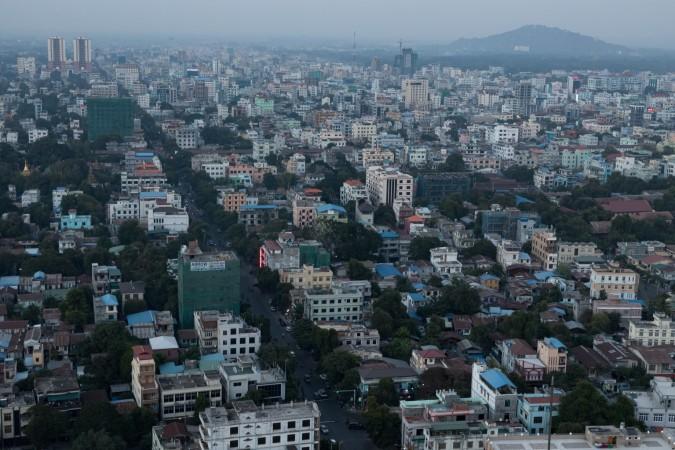
Overview of Mandalay
History & Cultural Influence
Mandalay served as the last capital of the Konbaung dynasty before the British annexation in 1885. It was established in an empty area, fulfilling an ancient prophecy that a great Buddhist city would be founded at the foot of Mandalay Hill.
Under British rule from 1885 to 1948, Mandalay remained commercially and culturally important despite the rise of Yangon as the new capital of British Burma. The city suffered damage during World War II when the Japanese installed a military camp in the former palace grounds.
Mandalay is considered the cultural and religious center of Buddhism in Myanmar, with numerous monasteries, over 700 pagodas, and the world's largest book at Kuthodaw Pagoda. The city is known for its unique styles of Buddha images and statues.
Interaction with The Locals
When interacting with locals in Mandalay, visitors can expect a warm and welcoming atmosphere, reflective of the city's diverse population. Mandalay has a population with the Bamar (Burman) ethnic group forming the majority. However, there is a significant presence of ethnic Chinese, Shan, and Indian communities, contributing to the city's multicultural character.
The general attitude towards tourists in Mandalay is friendly and curious. Locals often show a genuine interest in engaging with visitors, sharing stories about their culture and traditions. Travelers may find that many people, especially in markets and tourist areas, are eager to practice their English and assist with directions or recommendations.
Visitors should be respectful of local customs, particularly when it comes to religious practices, as Mandalay is a center of Buddhism in Myanmar.
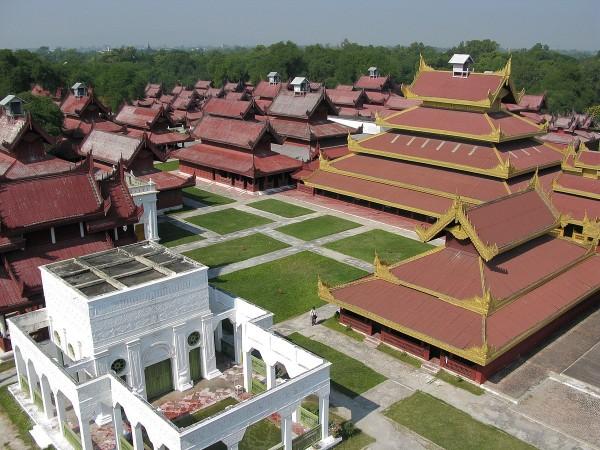
Mandalay Palace - © Vyacheslav Argenberg
Top attractions in Mandalay
Mandalay, the last royal capital of Myanmar, is steeped in history and culture, offering visitors a rich tapestry of attractions. Key highlights include the Mandalay Palace, a majestic symbol of the last Burmese monarchy with its grand architecture and the panoramic views from Mandalay Hill, which provides a spiritual experience with its many pagodas and monasteries.
Mandalay Palace
Location: Between 12th Street and 26th Street in central Mandalay
Mandalay Palace offers a rich glimpse into Myanmar’s royal history, serving as the last royal palace of the Burmese monarchy. Beyond its historical significance, visitors can enjoy cultural events and traditional Myanmar dance performances held within its walls. These events provide a deeper appreciation of the country’s royal customs and heritage, making the palace a dynamic spot for both history buffs and culture enthusiasts.
Kuthodaw Pagoda
Location: At the base of Mandalay Hill
Kuthodaw Pagoda is often referred to as the world’s largest book, with its 729 marble slabs inscribed with Buddhist scriptures. The surrounding peaceful gardens and smaller shrines offer a serene escape from the city’s busyness. During local festivals, the pagoda becomes especially enchanting, lit up and filled with the sound of monks chanting in unison, creating an unforgettable spiritual atmosphere.
Shwenandaw Monastery
Location: Near Mandalay Royal Palace
Shwenandaw Monastery is a masterpiece of intricate teak carvings, making it one of the finest examples of traditional Myanmar architecture. It’s more than just a visual marvel, though; the monastery remains an active site of worship. Visitors have the opportunity to witness Buddhist rituals and meditation sessions, offering a unique chance to immerse themselves in the spiritual side of Myanmar’s culture.
U Bein Bridge
Location: In Amarapura, about 11 km south of Mandalay
U Bein Bridge, the longest teak bridge in the world, is an iconic symbol of Myanmar. A visit during early morning or late evening allows for a peaceful, less crowded experience. Watching local monks and villagers walk across the bridge as the sun rises or sets gives visitors a fascinating glimpse into daily life along the serene Taungthaman Lake.
Mahamuni Buddha Temple
Location: In the southwest of Mandalay city
Mahamuni Buddha Temple is a deeply spiritual site, where male devotees apply gold leaves to the revered Mahamuni Buddha image as part of a daily ritual. The temple complex is alive with activity, surrounded by bustling markets selling religious artifacts and traditional Burmese crafts. For visitors, it’s a chance to engage with Myanmar’s spiritual practices and pick up a few souvenirs along the way.
Mingun Pahtodawgyi
Location: In Mingun, about 11 km northwest of Mandalay
Mingun Pahtodawgyi is an unfinished stupa with a massive, cracked facade that tells a story of ambition and disaster. Though incomplete, it remains a striking structure, offering great photographic opportunities against the scenic backdrop of the Irrawaddy River. History and photography lovers alike will find this site particularly captivating.
Sagaing Hills
Location: Across the Irrawaddy River, about 20 km (12 miles) southwest of Mandalay
Sagaing Hills is a haven of tranquility, known for its stunning panoramic views of the plains and the Irrawaddy River. The hills are dotted with numerous monasteries and pagodas, making it a popular spot for meditation retreats. It’s also a favorite for visitors seeking peaceful moments and breathtaking sunsets over the vast, serene landscape.
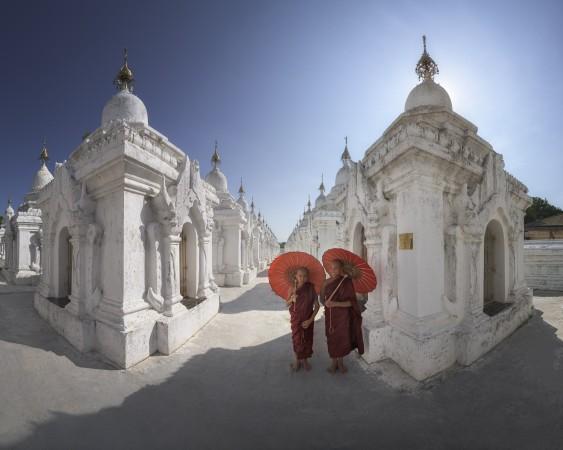
Kuthodaw Pagoda - © Andrey Omelyanchuk
Must-Try Dishes in Mandalay
Mandalay's cuisine offers a captivating blend of flavors and textures, making it a must-visit for food enthusiasts. One of the city's specialties is Mohinga, a rich and savory fish noodle soup that is considered Myanmar's national dish, often enjoyed as a hearty breakfast. These dishes not only delight the palate but also provide a deep insight into the traditional food culture of Mandalay.
Mandalay Moun Kywe (Mandalay-style Noodles)
Thick, round rice noodles served in a savory broth with chicken, chickpea fritters, crispy noodles, and garnishes like coriander, lime, and chili sauce. This popular breakfast dish in Mandalay showcases the city’s culinary heritage, with handmade noodles and bold flavors reflecting local preferences.
Shan Noodles
Thin rice noodles served with either chicken or pork, accompanied by a light broth or a dry sauce made with tomatoes and spices, often garnished with crispy noodles, coriander, and lime. The widespread popularity of Shan noodles in Mandalay highlights the city’s diverse culinary influences and its role as a cultural melting pot.
Moun Hin Gha (Chickpea Noodle Soup)
A hearty soup featuring round rice noodles in a chickpea-based broth, topped with chicken, boiled eggs, crispy noodles, and garnishes like coriander and lime. As a traditional breakfast dish, Moun Hin Gha showcases the importance of chickpeas in Burmese cuisine.
Mandalay Mont Di (Noodle Salad)
Thin rice noodles tossed with chicken, chickpea fritters, crispy noodles, and a tangy dressing made with tamarind, chili, and lime. This signature dish of Mandalay reflects the local preference for bold flavors and textures, especially as a morning meal.
Shan Tofu
Made from chickpea flour, Shan tofu has a soft, custard-like texture and is often served as a salad or snack, typically topped with crispy noodles, crushed peanuts, and a tangy dressing. This unique specialty showcases the culinary ingenuity of the Shan people, using locally available ingredients to create a distinctive dish.
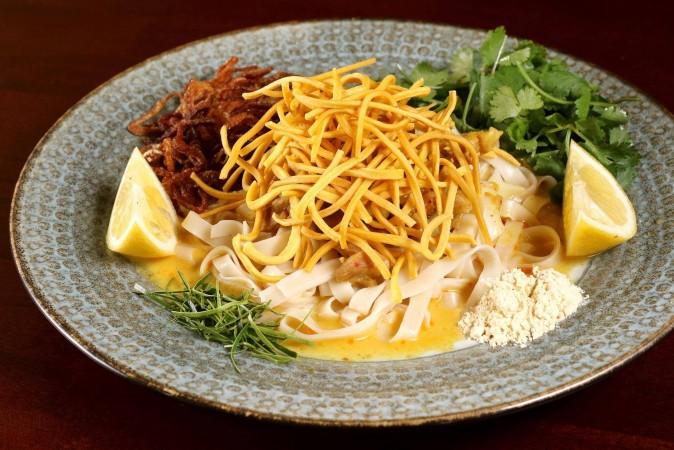
Mandalay Moun Kywe - © gather
Festivals & Local Celebrations
Thingyan Water Festival
When: April 13-16
Marks the Myanmar New Year and is celebrated with joyous water throwing. The streets come alive with music, dance, and people splashing water on each other from stages and vehicles. You can join in the fun, experience the festive atmosphere, and witness the cleansing rituals that usher in the new year.
Thadingyut Festival of Lights
When: October 9-11
This festival celebrates the Buddha's descent from heaven and marks the end of Buddhist Lent. Houses, streets, and pagodas are adorned with colorful lights and candles, creating a magical ambiance. Visitors can explore the vibrant markets, sample local delicacies, and witness the lighting of oil lamps at pagodas, especially at the Shwedagon Pagoda.
Mahamuni Pagoda Festival
When: March 15-April 15
Held in honor of the sacred Mahamuni Buddha image, one of the most revered in Myanmar. Visitors can witness the daily rituals of pouring water over the image, see the intricate carvings and architecture of the pagoda complex, and experience the devotion of the pilgrims who come from all over the country to pay their respects.
Kyauk Taw Gyi Pagoda Festival
When: October 30-November 2
Takes place at the Kyauk Taw Gyi Pagoda, known for its massive marble Buddha image. Visitors can join the colorful processions, attend cultural performances, and participate in the offerings and rituals that take place during the festival.
Elephant Dance Festival
When: October 30-November 1
An unique festival features the creation of life-size paper elephants, one black and one white, each with two men inside. The elaborately decorated elephants dance through the streets, accompanied by music and cheering crowds. Visitors can witness this vibrant display of Burmese culture and tradition.
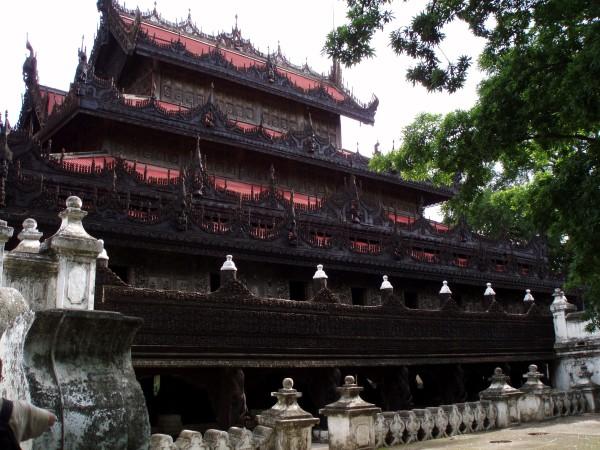
Shwenandaw Monastery - © gather
Weather in Mandalay: Best Time to Visit
Mandalay experiences a tropical wet and dry climate, characterized by distinct wet and dry seasons. Here are the key details about its weather and climate:
Average Temperatures
- Yearly Average: Approximately 28.1°C (82.58°F).
- Warmest Month: April, with average highs reaching around 37.95°C (100.31°F).
- Coldest Month: January, with average lows around 14.42°C (57.96°F).
Rainfall
- Annual Precipitation: About 78.25 mm (3.08 inches), with the wettest month being August, receiving approximately 182.11 mm (7.17 inches).
- Rainy Days: Mandalay has about 149.9 rainy days annually, primarily from May to October.
Best Time to Travel
- Optimal Travel Period: The best time to visit Mandalay is during the dry season from November to February when temperatures are cooler and rainfall is minimal. This period offers pleasant weather for outdoor activities and sightseeing.
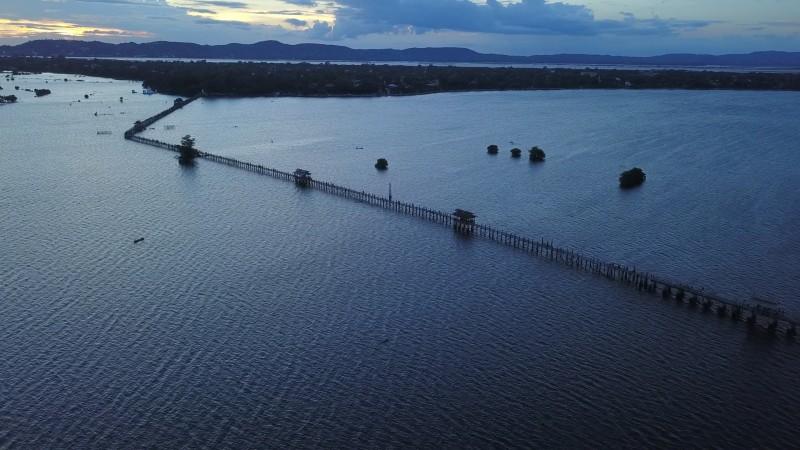
U Bein Bridge - © Heinz Htetz
Culture Etiquette in Mandalay
Greetings and Interactions
- Respectful Greetings: When meeting someone, a common greeting is to place your hands together in front of your chest and bow slightly. This gesture shows respect, especially when addressing elders or monks.
- Use of Hands: In Myanmar, the right hand is considered honorable, while the left hand is seen as impolite. Always use your right hand when giving or receiving items, including food.
Dress Code
- Modesty is Key: When visiting religious sites, it is important to dress modestly. Both men and women should wear long trousers and shirts that cover the shoulders. Women should avoid short skirts and overly revealing clothing.
- Footwear: Shoes must be removed before entering temples and pagodas. It is advisable to wear easy-to-remove footwear for convenience.
Religious Sensitivity
- Respect for Buddhism: Buddhism plays a significant role in Myanmar's culture. Visitors should be respectful at religious sites, avoiding any actions that may be seen as disrespectful, such as pointing feet at Buddha images or touching monks.
- Photography: While taking photos is generally acceptable, it is important to ask for permission before photographing people, especially monks or during religious ceremonies.
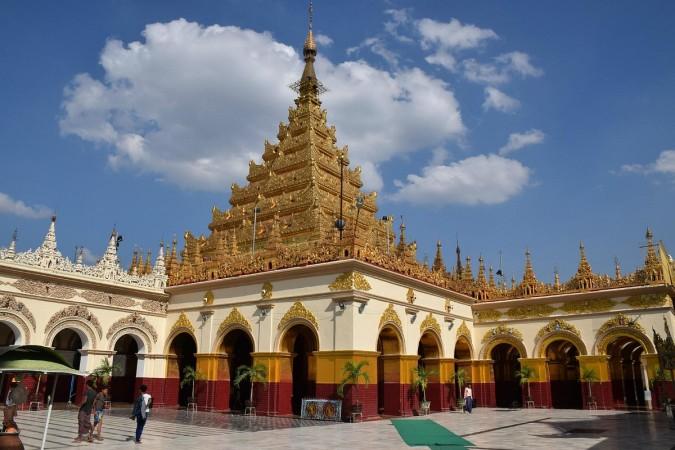
Mahamuni Buddha Temple - © gather
Essential Travel Information
Transportation
Airport Transfers
Mandalay International Airport (MDL): Located about 45 km (28 miles) from the city center, the airport serves both domestic and some international flights. There are several transportation options:
- Taxi: The most convenient option is to take a taxi, which costs around USD 10 (MMK 15,000) and takes about 55 minutes to reach the city.
- Shared Taxi/Minibus: A more economical choice, costing approximately USD 4 (MMK 4,000), but the journey may take longer (up to 1.5 hours) as it waits for more passengers.
- Private Transfer: For a more personalized experience, private transfers can be arranged through hotels or travel agents.
Public Transit
- Bus Services: Mandalay has several bus stations, including:Kywe Se Kan Highway Station: The largest, located about 8 km from the city center, servicing long-distance routes.
- Pyi Gyi Myat Shin Bus Station: Located southeast of downtown, serving routes like Pyin U Lwin and Hsipaw.
- Thiri Mandala Bus Station: The closest to the city center, servicing routes to Shwebo and other destinations.
Taxis and Ride-Sharing
- Taxis: Taxis are widely available in Mandalay. It’s common for drivers not to use meters, so it’s best to negotiate fares in advance. Expect to pay around USD 3-5 for short trips within the city.
- Ride-Sharing Services: While traditional ride-sharing apps like Grab may not be as prevalent, local taxi services can be hired through phone apps or by flagging them down in the streets.
Other Transportation Options
- Trishaws: These three-wheeled bicycles are a popular and fun way to explore the city, especially for short distances.
- Bicycles and Motorbikes: Renting a bicycle is a great way to see the city at your own pace, while motorbike taxis are available but should be used with caution, especially after dark.
ATM and Banking Services
- KBZ Bank and CB Bank are two major banks in Mandalay that offer ATM services. KBZ Bank has multiple ATM locations throughout the city, including branches and shopping malls.
- ATMs in Mandalay generally accept international cards, allowing travelers to withdraw Myanmar Kyat (MMK). The exchange rate may vary between banks and authorized exchange counters.
- Banking hours are typically from 9:30 AM to 3:30 PM, Monday to Friday, with some banks closed on weekends. It's advisable to plan accordingly if you need banking services.
Accommodation Choices
Mandalay offers a range of accommodation options to suit different budgets and preferences:
Luxury Hotels:
- Rupar Mandalar Resort
- Mandalay Hill Resort
- Hilton Mandalay
Mid-Range Hotels:
- Hotel Yadanarbon
- Mandalay City Hotel
- Amazing Mandalay Hotel
Budget Accommodation:
- Ostello Bello Mandalay
- Mandalay Central Hotel
- Shwe Pyi Thar Hotel
Articles for you

Explore Yala National Park - Sri Lanka Travel, Asia
Tucked away in Sri Lanka’s southeastern corner, Yala National Park is where wild nature meets deep tradition. Known worldwide for its leopard population, the park is also home to elephants, sloth bears, crocodiles, and hundreds of bird species. Beyond wildlife, Yala opens doors to a cultural landscape dotted with ancient temples, Buddhist ruins, and coastal villages. For travelers seeking more than just a safari, Yala offers a chance to explore eco-tourism, local communities, and sacred heritage sites.
Population: The Yala National Park area doesn’t have a human population.
Economy: The economy around Yala National Park thrives on a blend of eco-tourism, agriculture, and local services. Safari tours, eco-lodges, and cultural experiences drive steady income for nearby towns like Tissamaharama and Kataragama, supporting thousands of families.
Landmarks: Famous for Block I of Yala and wildlife encounters, including elephants, sloth bears, crocodiles, and exotic bird species.

Explore Galle - Sri Lanka Travel, Asia
Nestled on Sri Lanka’s southern coastline, Galle is a vibrant city where history meets the sea. Its cobbled streets, colonial architecture, and serene beaches make it a must-visit destination for travelers seeking a blend of culture, adventure, and relaxation. A UNESCO World Heritage site, Galle captivates visitors with its Dutch Fort, bustling markets, and friendly locals. Whether you’re exploring the ramparts at sunset or savoring fresh seafood by the shore, Galle promises an unforgettable journey into Sri Lanka’s heritage.
Population: Approximately 113,000 in 2023.
Economy: Galle’s economy thrives on tourism, trade, and fisheries. The city’s historic fort, colonial architecture, and coastal charm draw thousands of international visitors each year, making tourism its main economic driver. Fishing remains vital for local livelihoods, supplying fresh seafood across the region.
Landmarks: Famous for the Galle Fort, Dutch Reformed Church & Maritime Museum, and Unawatuna Beach.

Explore Bentota - Sri Lanka Travel, Asia
Nestled along Sri Lanka’s southwestern coast, Bentota is a tropical paradise that blends golden beaches, vibrant culture, and thrilling adventures. Famous for its calm waters, luxury resorts, and scenic river estuary, Bentota has become a top destination for travelers seeking both relaxation and authentic experiences. From serene beach walks at sunrise to adrenaline-pumping water sports, this coastal town offers a perfect balance of leisure and exploration. With its proximity to Colombo and Galle, Bentota is easy to reach, making it an ideal stop for both short escapes and extended holidays.
Population: Approximately 37,000 in 2023.
Economy: Bentota’s economy thrives mainly on tourism, which drives local businesses such as hotels, restaurants, and wellness retreats. The town also benefits from fishing, coconut cultivation, and handicrafts like wood carving and batik textiles. Many residents rely on the growing demand for water sports and Ayurvedic treatments, making tourism the backbone of both income and employment in the area.
Landmarks: Famous for Bentota Beach, Bentota River Safari, and Kande Vihara Temple.

Explore Mirissa - Sri Lanka Travel, Asia
Mirissa is a charming coastal town on Sri Lanka’s southern shoreline. Known for its golden beaches, turquoise waters, and vibrant marine life, it has become a must-visit stop for travelers exploring the island. Many come for whale watching, surfing, and sunset views at Coconut Tree Hill, but Mirissa offers much more than postcard beauty. The fishing boats you see anchored by the bay carry generations of stories. Local traditions, delicious cuisine, and a laid-back rhythm of life shape every visitor’s experience.
Population: Approximately 4,700 in 2023.
Economy: Mirissa’s economy is largely shaped by its coastal location. Fishing has long been the backbone of local livelihoods, with generations relying on the Indian Ocean for income. In recent decades, tourism has become the main driver of growth, thanks to whale watching, surfing, and beachside hospitality.
Landmarks: Famous for Mirissa Beach, Coconut Tree Hill, and Parrot Rock Bridge.

Explore Nuwara Eliya - Sri Lanka Travel, Asia
Tucked away in the Central Highlands of Sri Lanka, Nuwara Eliya is often called “Little England”. With its rolling tea plantations, cool misty mornings, and colonial charm, this mountain town feels like a step into another world. Travelers come here to breathe fresh air, walk through flower gardens, sip the finest Ceylon Tea, and enjoy a pace of life far from the island’s busy cities. Whether you’re drawn by scenic landscapes, heritage architecture, or the warmth of its people, Nuwara Eliya is a destination that blends nature, culture, and history in perfect harmony.
Population: Approximately 781,000 in 2023.
Economy: Nuwara Eliya’s economy thrives mainly on tea production, as it sits in the heart of Sri Lanka’s central highlands, famous worldwide for Ceylon Tea. The city also benefits from a growing tourism industry, attracting visitors with its colonial charm, cool climate, and scenic landscapes.
Landmarks: Famous for Gregory Lake, Hakgala Botanical Garden, and Victoria Park.

Explore Sukau - Malaysia Travel, Asia
Nestled on the banks of the Kinabatangan River in Sabah, Malaysian Borneo, Sukau is a destination where wildlife, culture, and conservation come together. Known as one of Asia’s top spots for river safaris and eco-tourism, this quiet village offers a front-row seat to encounters with Bornean orangutans, pygmy elephants, proboscis monkeys, and exotic birdlife.
Population: Approximately 1,400 in 2019.
Economy: Sukau’s economy is shaped by its riverine location and natural resources. Traditionally, the Orang Sungai community relied on fishing, small-scale farming, and forest gathering for their livelihood. Today, the village has shifted toward eco-tourism, with river cruises, jungle trekking, and homestays providing income.
Landmarks: Famous for the Kinabatangan River cruises, Gomantong Caves, and Ox-bow lakes and wetlands.
